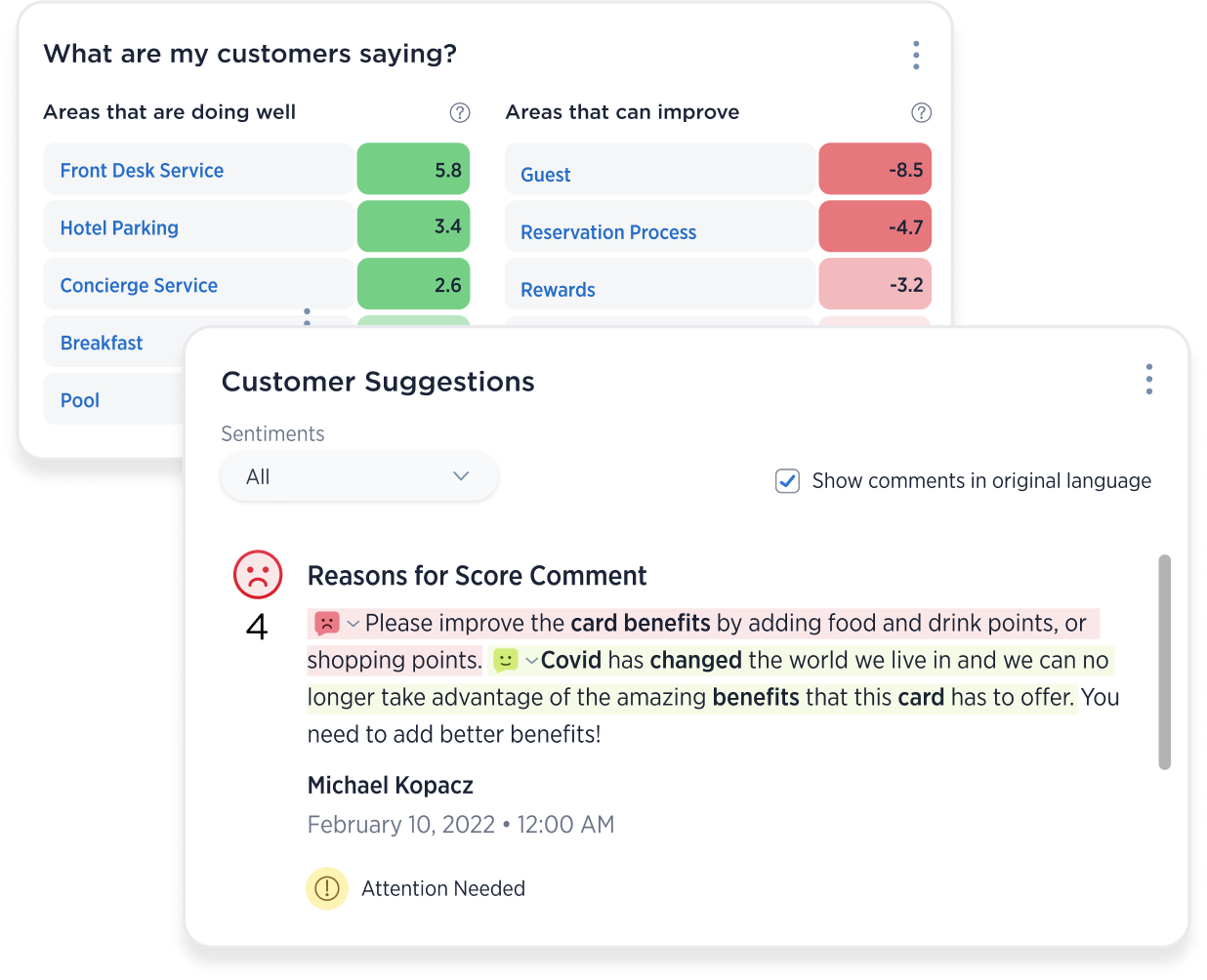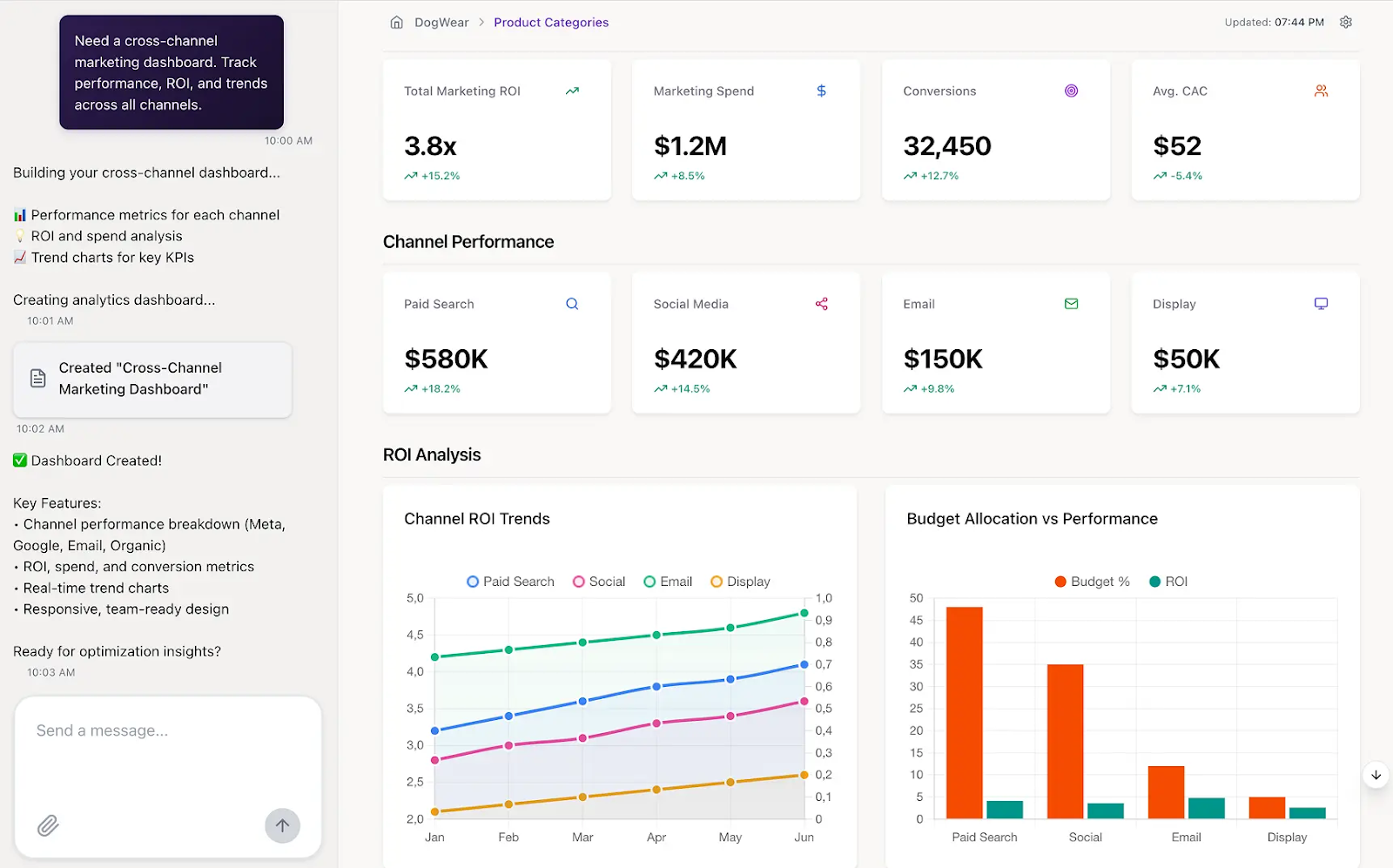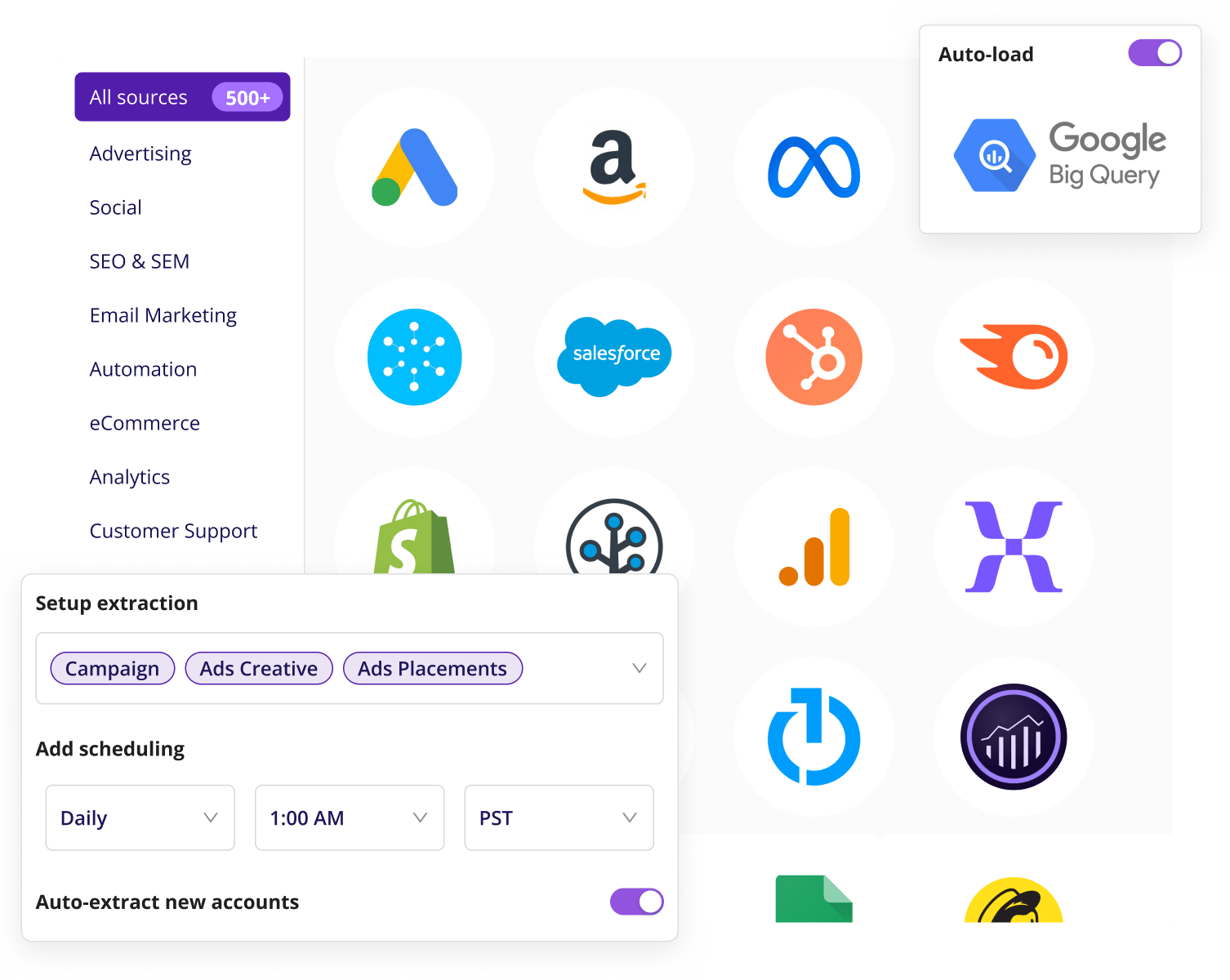The buzz around AI in analytics and marketing, in general, makes it seem like everyone's riding the high-tech wave, AI-ing their strategies to the nth degree. Yet, many marketers are still figuring out how to integrate AI into their daily operations.
This guide explores the world of AI-driven marketing insights. We will cover everything from core concepts to advanced strategies. You will learn how AI transforms data into your most powerful asset.
Key Takeaways:
- Definition: AI analytics the use of artificial intelligence, machine learning, and NLP to analyze marketing data, predict outcomes, and automate insights.
- Importance: AI provides a competitive edge by enabling proactive decision-making, hyper-personalization, and improved marketing ROI.
- Core use cases: Key applications include advanced customer segmentation, predictive lead scoring, sentiment analysis, and campaign optimization.
- Strategic implementation: Success requires clear goals, unified data, a pilot program, and a culture that embraces data-driven strategies.
- The Improvado advantage: A unified data platform is the foundation for effective AI. It provides the clean, organized data AI models need to deliver accurate insights.
What Is AI Marketing Analytics?
AI marketing analytics is the application of artificial intelligence technologies to marketing data. The goal is to produce deep, actionable insights. This includes learning from data, recognizing patterns, and making predictions.
It is about using algorithms to process information at a scale and speed humans cannot match. This allows for more precise targeting and personalization in every campaign.
The Core Components: Machine Learning, NLP, and Predictive Models
Three key technologies power AI marketing analytics:
- Machine Learning (ML): This is a subset of AI where algorithms learn from data without being explicitly programmed. ML models identify patterns in your campaign data to predict future outcomes, like which customers are likely to churn.
- Natural Language Processing (NLP): NLP gives computers the ability to understand human language. In marketing, it's used for sentiment analysis, chatbots, and analyzing voice search queries.
- Predictive models: These models use historical data and ML algorithms to forecast future events. This can include predicting sales, customer lifetime value, or the success of a marketing campaign.
Comparison: Traditional vs. AI-Powered Analytics
To fully appreciate the impact of AI, it's helpful to compare it directly with traditional analytics methods. The differences highlight a fundamental shift in how marketing data is leveraged.
The Strategic Importance of AI in Modern Marketing
Why should businesses bother AI-ing their marketing analytics? The integration of AI into marketing analytics not only streamlines operations but also unveils opportunities previously hidden in vast amounts of data.
The digital landscape is too complex and fast-moving for manual analysis alone. AI provides the tools to navigate this complexity with confidence and precision.
Moving from Reactive to Predictive Decision-Making
Traditional marketing often reacts to past performance. You see a drop in conversions, so you adjust your strategy.
AI allows for a shift to a predictive approach. It can identify leading indicators of a performance drop before it becomes significant. This lets you make proactive adjustments, saving time and budget while improving overall results.
Gaining a Sustainable Competitive Advantage
Companies that effectively use AI gain a significant edge. They understand their customers on a deeper level. They can anticipate market shifts and respond faster than competitors.
This data-driven agility creates a powerful, sustainable advantage that is difficult for others to replicate without similar technological capabilities.
Enhancing Personalization at Scale
Today's consumers expect personalized experiences. AI makes this possible on a massive scale. By analyzing individual user data, AI can help deliver the right message to the right person at the right time. This improves the customer journey and boosts engagement, loyalty, and conversions.
Drastic Improvements in Team Productivity
AI significantly enhances team productivity by automating repetitive and time-intensive tasks such as data analysis, campaign reporting, and customer segmentation.
Core Capabilities of AI Marketing Analytics Platforms
Modern AI analytics platforms offer a suite of powerful capabilities. These features are designed to handle the entire data lifecycle. From collection to insight generation, these platforms streamline complex processes for marketing teams. This empowers marketers to focus on strategy instead of data wrangling.
- Automated data integration and cleansing: The foundation of any AI system is high-quality data. AI platforms automate the process of collecting data from hundreds of sources. They clean, normalize, and structure this data. This ensures the AI models are working with accurate information, which is crucial for reliable insights.
- Predictive analytics and forecasting: A core function is predicting future trends. These platforms can forecast key metrics like sales, web traffic, and lead generation. This helps with resource planning and budget allocation. It gives marketers a clear view of expected outcomes, allowing for better strategic planning.
- Real-time anomaly detection: AI systems constantly monitor your data streams. They can instantly detect unusual patterns or anomalies. For example, it might flag a sudden drop in click-through rates on an ad. This real-time alert enables you to address issues immediately, minimizing negative impact.
- Natural language querying and reporting: One of the most transformative features is the ability to ask questions in plain English. Marketers can simply type "Show me the top-performing campaigns by ROAS last quarter." The AI translates this into a complex query, retrieves the data, and presents it in an easy-to-understand format. This democratizes data analytics for the entire team.
Top 7 AI Use Cases in Marketing Analytics
Let's explore practical ways AI analytics transforms how businesses operate. These use cases show how AI enhances decision-making across the marketing spectrum. From customer understanding to content strategy, AI provides a sharper edge.
1. Advanced Customer Segmentation with Machine Learning
Applying AI, particularly machine learning (ML), to customer segmentation helps transform vast amounts of data into precise and actionable groups.
AI can identify segments based on predicted behaviors, such as the likelihood of repeat purchases or susceptibility to churn. By integrating with campaign management tools, AI enables marketers to quickly target these segments with personalized content, optimizing marketing spend by focusing on high-value or at-risk customers.
Other examples of AI-driven customer segmentation:
- Psychographic segmentation: AI can delve into the psychographic aspects of customer data, categorizing consumers by personality traits, values, interests, and lifestyles, which can be incredibly useful for crafting resonant messaging and offers.
- Event-triggered segmentation: AI systems can segment customers based on their reactions to certain events, such as product launches or major sales. This helps in understanding how different customer segments engage with specific brand activities.
- Cross-sell and upsell segmentation: AI can identify which customers are likely to be interested in additional products or upgrades, helping marketers tailor cross-sell and upsell campaigns to receptive segments.
Over time, machine learning can further refine these segments by continuously learning from campaign outcomes, leading to even more personalized customer experiences and better conversion rates.
2. Predictive Lead Scoring and Prioritization
Not all leads are created equal. Predictive models analyze historical conversion patterns, enrichment data, engagement signals, account attributes, campaign touchpoints, and even product-usage indicators (for PLG funnels) to identify what truly differentiates high-quality leads from the rest.
Using these patterns, the system automatically scores every new lead or account based on its likelihood to convert, update, or expand. Scores can even adjust dynamically as behaviors change or new data enters the system.
With this level of intelligence, sales and marketing teams can prioritize outreach, route leads more intelligently, personalize follow-ups, and invest resources where the highest impact is statistically most likely.
3. Running Data Workflows for Marketing Analytics
Modern marketing analytics relies on consistent, automated data workflows. AI makes these workflows easier to manage by handling the work that typically slows teams down—data extraction, processing, normalization, validation, and modeling.
With AI, marketers no longer need to configure complex connectors or maintain brittle scripts. Instead, AI agents interpret natural-language instructions, pull data from APIs, and structure everything into analysis-ready formats.

Here’s an example of Improvado AI Agent that can streamline these marketing data operations. It automates key steps in the workflow:
Data extraction:
- Automatic connector configuration: The Agent selects the right API endpoints, authentication methods, and available data streams without manual setup.
- Smart field mapping: AI identifies relevant dimensions, metrics, and nested structures, mapping them into a normalized schema.
- Pre-filter extraction: Pull only the data you need (dates, campaigns, metrics, accounts), reducing load time, storage, and noise.
- Schema validation: The Agent detects mismatches or breaks (e.g., missing columns, renamed metrics) and corrects them before loading.
- Incremental extraction logic: Automatically configures date-range windows and delta loads to keep pipelines efficient.
Data transformation:
- Automated normalization: Standardizes naming conventions, metric definitions, and data types across platforms.
- Table merging & relationship modeling: The Agent identifies related tables and joins them into unified entities like Campaign, AdGroup, Audience, or Spend.
- Error correction & anomaly handling: Fixes formatting inconsistencies, strips invalid characters, resolves nulls, and flags outliers.
- Metric engineering: Creates calculated fields (ROAS, conversion rate, LTV windows, cost aggregates) based on plain-language instructions.
- Reusable transformation recipes: The Agent can store transformation logic and re-apply it across clients, regions, or datasets.
Orchestration:
- Self-maintaining pipelines: The Agent monitors workflow health and resolves common extraction or transformation issues automatically.
- Load scheduling: Automatically sets and adjusts refresh frequencies based on data availability and volume.
- Unified cross-channel modeling: Ensures that every workflow outputs consistent, comparable tables regardless of the source.
- Production-grade reliability: Handles multi-channel, high-volume datasets without the breakage typical of manual or script-based pipelines.
4. Dynamic Pricing and Promotion Optimization
AI can analyze market demand, competitor pricing, and customer behavior in real-time. This allows e-commerce and retail businesses to implement dynamic pricing strategies. The system can automatically adjust prices to maximize revenue. It can also determine the optimal discount to offer a specific customer segment to encourage a purchase.
5. Sentiment Analysis with Natural Language Processing (NLP)

Marketers often face the challenge of deciphering customer opinions on new product launches or brand campaigns. While traditional survey methods provide direct insights, they can be time-consuming, may not capture the spontaneous sentiments expressed across digital platforms, and often show socially accepted answers.
Social sentiment analysis platforms powered by Natural Language Processing (NLP), on the other hand, can swiftly sift through large volumes of text to identify sentiment at scale. It's adept at processing data from social media, customer reviews, and discussion forums to discern general mood and opinion trends.
Marketers are now turning to Large Language Models (LLMs) like ChatGPT, with its standard chat interface, sentiment analysis plugins, and API, for enhanced sentiment analysis. Since it has been trained on a vast corpus of text data it is expected to address some of the issues of more traditional monitoring tools:
- LLMs can consider the broader context in which a statement is made, potentially leading to more accurate sentiment interpretation.
- LLMs can be fine-tuned and customized for specific industries or topics, which can improve the accuracy of sentiment analysis for niche markets or particular types of products.
- Unlike standalone tools, LLMs can be integrated into a broader AI ecosystem, combining sentiment analysis with other data sources for a more holistic understanding of customer opinions.
6. Ad-Hoc Analytics
Ad-hoc analytics is where marketers need answers fast: whether it’s a quick ROAS breakdown, a spike in CPC, or a last-minute budget question. Instead of waiting on analysts, dashboards, or SQL queries, AI gives teams instant access to the insights they need.

Improvado’s AI Agent brings this capability directly into the marketing workflow. Teams can ask analytical questions in natural language and get precise answers generated from unified, warehouse-backed data models. The Agent produces tables, comparisons, and visualizations on demand, and can save them into native dashboards for ongoing use.
It also supports scheduled queries, allowing recurring analytics checks to be delivered automatically. With context-aware follow-up, such as refining results by audience, device, or date range, marketers can explore data interactively without writing SQL or waiting on analysts.
By making high-quality analytics accessible in real time, AI Agent enables teams to investigate performance, validate assumptions, and make decisions at the pace modern marketing requires.
7. AI for Voice Search Optimization
The landscape of search has changed significantly. 50% of consumers in the U.S. turn to voice assistants for their queries daily. 34% use voice search weekly, and 16% monthly.
The importance of optimizing content for voice search becomes vital. This shift means moving beyond traditional keywords to a more conversational approach that aligns with natural speech patterns.
Artificial intelligence is nailing this approach. It helps analyze large volumes of voice search data to detect patterns in the way people phrase their queries. This insight is crucial for shaping content that fits seamlessly into the voice search narrative, ensuring your brand's visibility in a voice-driven world.
Here’s a couple of AI applications for voice search optimization and analysis:
- Voice search analytics: AI algorithms can analyze the tone, phrasing, and semantics of voice queries to uncover what users are really asking for. Marketers can use these insights to craft SEO strategies that resonate with the natural, informal style of spoken searches.
- Understanding voice searches with NLP: Natural Language Processing (NLP) gives AI the ability to interpret the intent and nuances of voice queries. This is crucial for creating content that speaks directly to the user, using the same conversational language that they use in their daily lives.
- Content that converses: The spoken word is naturally engaging, and AI can help create content that captures this conversational quality. By using algorithms that specialize in generating human-like text, AI tools enable marketers to produce content that feels like one side of a dialogue. This kind of content is naturally suited to voice search and can dramatically improve a brand's visibility in voice search results.
- Semantic search optimization: AI analytics solutions helps understand semantic search, where the context and relationship between words are analyzed to provide more accurate search results. By optimizing content for semantic search, marketers improve the chances of their content matching with the user's intent.
- Automated testing and optimization: AI can automate A/B testing for SEO strategies to determine what works best for voice search. This includes testing various aspects of content, from keyword density to the structure and format, to improve its discoverability via voice search.
- Classifying Search Intent with AI: AI analytics tools can be trained to classify the intent behind voice searches more effectively, distinguishing between informational, navigational, transactional, and local intents. This classification helps in creating more targeted content.
A Deep Dive into Conversational Analytics
One of the most exciting advancements in AI marketing analytics is conversational analytics. This technology fundamentally changes how marketers interact with their data. It removes technical barriers and makes sophisticated analysis accessible to everyone on the team.
What Is Conversational Analytics?
Conversational analytics, also known as search-driven, search-based analytics, or natural language analytics, allows users to get insights by asking questions in natural language.
Instead of building complex reports or writing code, you can use a chat-like interface. It feels like having a conversation with a data analyst who has instant access to all your information. This immediate feedback loop accelerates the decision-making process.
How Text-to-SQL Technology Empowers Marketers
Behind the scenes, this magic is powered by Text-to-SQL technology. When a marketer asks a question, the AI model interprets the intent. It then translates the English question into a precise SQL query. This query is run against the database, and the results are returned to the user in a clear, easy-to-digest format, often with charts and graphs.
Choosing the Right AI Marketing Analytics Tools
The market for AI marketing tools is growing rapidly. Selecting the right solution can be a daunting task. It is important to look beyond the hype and focus on tools that solve your specific business challenges. A systematic approach to evaluation is key to making a successful investment.
Key Features to Look For in an AI Tool
When evaluating different AI marketing analytics tools, prioritize these features:
- Automated data integration: The tool must easily connect to all your marketing data sources without extensive manual setup.
- User-friendly interface: The platform should be intuitive for non-technical users. A conversational interface is a major plus.
- Customizable models: The ability to tailor AI models to your specific business logic and KPIs is crucial for relevant insights.
- Actionable recommendations: The best tools don't just show you data; they provide clear, actionable suggestions for improvement.
- Scalability: The solution should be able to grow with your data volume and business complexity.
Platform vs. Point Solutions: Which is Right for You?
You can choose between a comprehensive platform or specialized point solutions.
Point solutions are great at one specific task, like sentiment analysis. However, this can lead to a fragmented tech stack. Each tool solves a narrow problem, leaving teams to stitch together data, maintain multiple workflows, and reconcile conflicting outputs. As a result, insights become harder to scale, automate, or trust, especially when multiple channels or teams are involved.
A platform approach consolidates these capabilities into a single environment. Instead of managing separate tools for extraction, modeling, analytics, activation, and reporting, a unified platform standardizes data, centralizes logic, and enables AI to operate on a complete, consistent foundation.
This not only reduces operational overhead but also improves the accuracy and impact of every AI-driven decision. For enterprise teams working across many sources and markets, a platform is the only sustainable way to build end-to-end AI marketing workflows.
Ultimately, the right choice depends on your goals, complexity, and scale but if your organization needs reliable insights, cross-channel truth, and automation that compounds over time, a unified platform will deliver far more value than isolated point solutions.
Developing an AI-Driven Marketing Strategy
Implementing AI is not just about buying software. It requires a strategic approach. Success depends on aligning the technology with your business goals. A phased approach ensures a smooth transition and maximizes the return on your investment.
Step 1: Define Clear Business Objectives
Start with the "why." What specific marketing challenges do you want to solve with AI? Are you trying to reduce customer churn, improve lead quality, or increase personalization?
Clear objectives will guide your implementation and help you measure success. Vague goals lead to unfocused efforts.
Step 2: Unify Your Marketing Data Sources
AI models need clean, comprehensive data. Your first technical step is to break down data silos. Use a platform like Improvado to aggregate all your marketing data into one centralized location. This creates the single source of truth necessary for accurate AI analysis.
Step 3: Implement a Pilot Program
Don't try to boil the ocean. Start with a small, focused pilot project. Choose one of your defined objectives, like predictive lead scoring for a specific product line. This allows you to test the technology, learn from the process, and demonstrate value quickly before a full-scale rollout.
Step 4: Foster a Data-Driven Culture
Technology alone is not enough. Your team needs to embrace a data-first mindset. Provide training on how to use the new tools and interpret the insights. Encourage experimentation and learning. Celebrate successes to build momentum and show the value of the new approach across the organization.
Step 5: Measure, Iterate, and Scale
Continuously monitor the performance of your AI initiatives against your initial goals. Use these learnings to refine your models and strategies. Once you have proven the value in your pilot program, you can begin to scale the solution to other areas of the business, building on your success.
Overcoming Challenges in AI Implementation
While the benefits of AI are significant, the path to implementation is not without its challenges. Being aware of these potential hurdles can help you plan for them. A proactive approach to addressing these issues is key to a successful AI adoption.
Addressing Data Quality and Governance
The saying "garbage in, garbage out" is especially true for AI. If your source data is inaccurate or incomplete, your AI-driven insights will be flawed.
Establishing strong data governance practices and using tools to ensure data quality is a critical first step that cannot be skipped.
Managing the "Black Box" Problem
Some complex AI models can be a "black box," making it difficult to understand how they reached a particular conclusion. This can be a problem when you need to explain a decision to stakeholders.
Look for AI solutions that offer explainability features. These features provide insight into the factors that influenced a specific prediction or recommendation.
Bridging the Skills Gap in Your Team
Your team may not have the skills to manage complex AI systems. It is important to invest in training and development.
Partnering with a vendor that provides strong support and services can also help bridge this gap. The goal is to empower your team, not replace them. A culture of continuous learning is essential for long-term success with AI.
The Future of AI in Marketing Analytics
The evolution of AI in marketing is accelerating. The capabilities we see today are just the beginning. Looking ahead, several key trends are set to further revolutionize the field. Staying informed about these developments will help you prepare for the next wave of innovation.
Hyper-Personalization and the Customer Journey
AI will enable a level of personalization we can only dream of today. It will be able to predict an individual customer's needs in real-time. This will allow for the creation of truly one-to-one marketing experiences across the entire customer journey. Every touchpoint will be uniquely tailored to that individual's context and intent.
Generative AI for Creative and Copy Optimization
Generative AI, the technology behind tools like ChatGPT, is already making an impact. In the future, it will be deeply integrated into analytics platforms. It will not only analyze performance but also generate new ad copy, email subject lines, and even images. It will then test these variations automatically to find the top-performing creative.
The Rise of Autonomous Marketing Operations
As AI models become more sophisticated, we will see the rise of autonomous marketing systems. These systems will not just provide recommendations; they will take action. An AI could manage entire ad campaigns, from budget allocation to creative optimization, with minimal human oversight. This will allow marketers to operate at an even more strategic level, focusing on overarching brand and business goals.
Conclusion
AI marketing analytics represents a paradigm shift. It moves us from a world of historical reporting to a future of predictive, automated, and personalized marketing. The journey begins with a solid data foundation. By unifying your marketing data, you create the fuel that powers these advanced AI engines.
Improvado provides that foundation. By centralizing cross-channel data, standardizing it into consistent models, and layering AI on top for analysis, reporting, and optimization, Improvado enables teams to unlock the full value of AI without rebuilding their infrastructure. It turns fragmented signals into a coherent system that AI can reason over—delivering faster insights, smarter decisions, and scalable automation.
If you want to see how a unified data foundation can accelerate your AI marketing strategy, book a demo with Improvado.
.png)
.jpeg)





.png)
